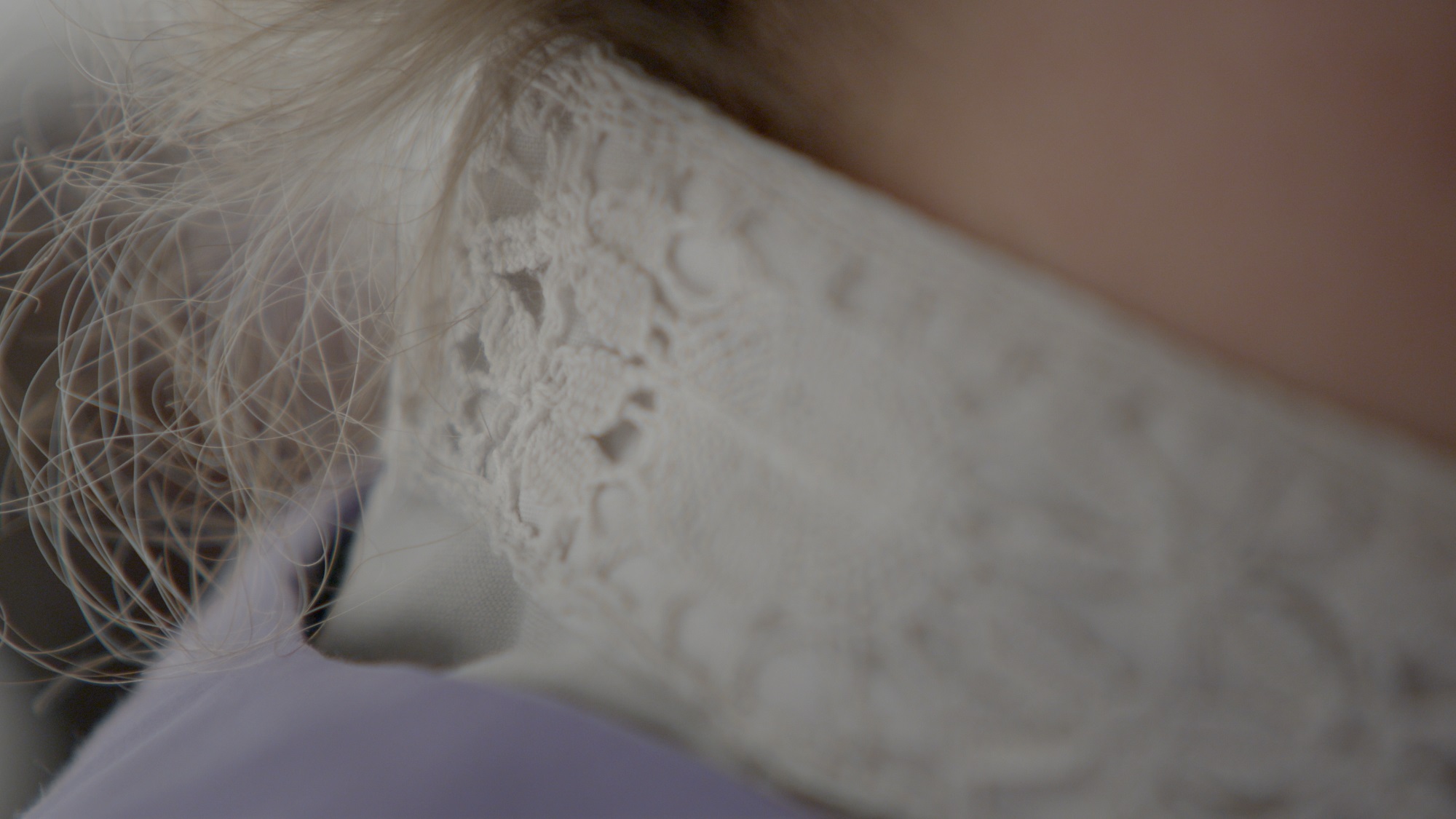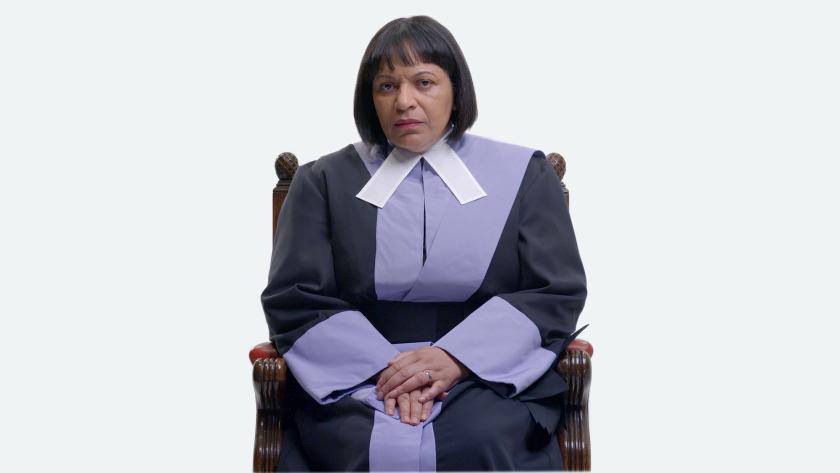A visitor to the city wishes to gain access to the law, but a gatekeeper blocks his entrance. The man petitions this imposing figure, who is only one of a series of legal bouncers. He is told there is gate after gate. He sits, he waits, he lies down, and eventually he expires. But not before making a close study of this implacable representative of the law. He even notes the fleas in the gatekeeper’s collar.
Such is the fate of a character in Franz Kafka’s paranoid short story Before the Law. It comes to mind since visitors to the Carey Young show at Modern Art Oxford are invited to spend, if not a lifetime, some 45 slow-going minutes sat before Appearance, 2023, a video portrait of a series of female judges who remain still, at bench, for minutes at a time (main picture). They wear grave expressions and full regalia; close ups show hair, lace cuffs, jewellery, drapery folds, and shoes (pictured below).
While there are no fleas in these ermine collars, the viewer, who finds themselves before the law in each case, will have little choice but to inspect the details of each subject. One can search in vain for the secrets of law in the carefully applied nail polish of a woman who, more usually, presides over a high court. But despite ornate wooden chair and gown rack in the wings, the perverse ordeal takes place in a photographic studio rather than chambers.
 In a second film here, we encounter judges in their own environment, a Brussels courthouse. This venue, the Palais de Justice, 2017, gives its name to a second film work. The building is a cavernous and theatrical labyrinth of marble and wood, through which we follow members of the legal profession up and down staircases and along interminable corridors. At work, we glimpse them via glass portholes in courtroom doors. Young made this surreptitious group portrait over several visits, without permission.
In a second film here, we encounter judges in their own environment, a Brussels courthouse. This venue, the Palais de Justice, 2017, gives its name to a second film work. The building is a cavernous and theatrical labyrinth of marble and wood, through which we follow members of the legal profession up and down staircases and along interminable corridors. At work, we glimpse them via glass portholes in courtroom doors. Young made this surreptitious group portrait over several visits, without permission.
Once again, the focus is on women. Women are seen asking questions, consulting papers, making statements and, once or twice as they spot the camera, meeting our gaze with calm authority. The interior space amplifies the lifts doors, trolleys, and footsteps of its denizens. At times the ambient soundtrack will ring with the staccato clicking of high heeled shoes.
But one woman here, who dares to differ, is barefoot. She is a young artist who, inspired by the architecture is sat on a sweeping staircase making a sketch of the vaulted interior. This world is quite different from Kafka’s; artists are reasonably free to come and go and judges, or at least those captured by Young during her incursions here, are exclusively women; they appear intelligent, approachable and somehow, one imagines, fair.
But it cannot be denied, the female judges in these two films are now themselves offered up for judgement. In an exhibition which bears the title Appearance, this applies, inevitably, to the sartorial and cosmetic decisions made by a group of legal representatives who are also a group of women. Women, arguably, can never be done with this sort of judgement, even when they hold high office. Both filmic portraits of judges almost dare the viewer to approach these powerful women with what has come to be known as the male gaze.
 This trap is made explicit by the third film in Young’s Oxford show. In The Vision Machine, 2020, she introduces the viewer to the SIGMA lens factory in Japan (pictured above). The operatives here take red hot glass from spinning belts, carefully polish it up as lenses, and assemble these into hefty attachments for cameras. The skill and precision needed for this work seems most suited to a team of women who, in their white lab overalls, resist objectification. The films combine to suggest a feminist utopia where justice is served and the gaze is gender neutral.
This trap is made explicit by the third film in Young’s Oxford show. In The Vision Machine, 2020, she introduces the viewer to the SIGMA lens factory in Japan (pictured above). The operatives here take red hot glass from spinning belts, carefully polish it up as lenses, and assemble these into hefty attachments for cameras. The skill and precision needed for this work seems most suited to a team of women who, in their white lab overalls, resist objectification. The films combine to suggest a feminist utopia where justice is served and the gaze is gender neutral.
Alongside are a number of wall mounted works offer equally radical ways of thinking about law. In Declared Void III, 2005/23, vinyl markings, evocative of a squash court rather than a law court, invites visitors to cross a line and step inside. Now they are, it says, free to declare themselves EU Citizens for the duration of their stay in this box. Another piece offers a text panel declaring a number of acts permissible in the gallery space, from taking photographs to gathering firewood. Printed back to front, the edict is best viewed in the adjacent black obsidian mirror which gives rise to the title Obsidian Contract, 2010.
Two more large format photographs are presented as a pair: Faculty of Law, Oxford University, 2022, and Prison Yard, Beveren, Belgium, 2022. One features a noticeboard from an academic law department; the other the wall of a prison yard. The dark pin board, with its notices removed, resembles the inverse of the scuffed white wall of the yard. This coupling is a visionary act which brings the hallowed activities of lawyers into very close quarters with those found guilty of breaking the law, albeit through a visionary looking glass.
There is an echo of Van Gogh’s Starry Night in the pinboard, of Andy Warhol’s Screen Tests, in the sitting judges, together with any number of renaissance portraits. But for me this is a show in which art historical trainspotting is beside the point.
Young is an original whose recent interest in law, like the interest she has previously shown in the corporate world, is among the most overlooked subject matters in art. Authority has a visual regime which supports its maintenance and operations. It is usually perceived as dark, dusty, dull, slow moving and bound up in weighty books and paper files. In this show, the law is slow but mesmerising, arcane but human, and filtered brightly by the camera lens.
This art uses reflection and refraction to transform the all-pervasive world of Kafka. Law here is permeable, rather than monolithic, and open to a spirit of subtle anarchy.









![SEX MONEY RACE RELIGION [2016] by Gilbert and George. Installation shot of Gilbert & George 21ST CENTURY PICTURES Hayward Gallery](/sites/default/files/styles/thumbnail_125_x_125_/public/mastimages/Gilbert%20%26%20George_%2021ST%20CENTURY%20PICTURES.%20SEX%20MONEY%20RACE%20RELIGION%20%5B2016%5D.%20Photo_%20Mark%20Blower.%20Courtesy%20of%20the%20Gilbert%20%26%20George%20and%20the%20Hayward%20Gallery._0.jpg?itok=3oW-Y84i)





Add comment